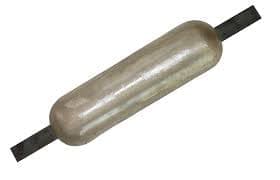How Sacrificial Anodes Work
When a sacrificial anode cathodic protection system is installed, the sacrificial anode corrodes preferentially, releasing electrons into the metal structure it's connected to. This influx of electrons effectively polarizes the metal structure, shifting its potential towards a less corrosive state. As a result, the protected metal remains intact while the sacrificial anode gradually corrodes over time.
Advantages of Sacrificial Anode Cathodic Protection
Passive Protection : Sacrificial anode cathodic protection operates without the need for external power sources or monitoring systems, making it a passive and cost-effective solution.
Ease of Installation : The installation of sacrificial anodes is relatively straightforward, requiring minimal expertise and equipment.
Effective in Harsh Environments : This protection system is particularly effective in corrosive environments such as marine environments, where traditional coatings or inhibitors may be less effective.
Low Maintenance : Once installed, sacrificial anodes typically require minimal maintenance, reducing long-term operational costs.
Applications of Sacrificial Anode Cathodic Protection
Sacrificial anode cathodic protection finds widespread application in various industries:
Marine Structures : Ships, offshore platforms, docks, and pipelines are often protected using sacrificial anode systems to mitigate corrosion in saltwater environments.
Underground Pipelines : Buried pipelines for transporting water, oil, or gas are susceptible to corrosion from soil moisture. Sacrificial anodes provide effective protection in these scenarios.
Storage Tanks : Tanks storing corrosive substances benefit from sacrificial anode cathodic protection to extend their service life and maintain structural integrity.
Conclusion
In the ongoing battle against corrosion, sacrificial anode cathodic protection systems stand as a stalwart defense, preserving the integrity and longevity of metal structures in the face of harsh environmental conditions. With their simplicity, effectiveness, and versatility, these systems continue to play a vital role in safeguarding critical infrastructure worldwide, ensuring safety, reliability, and sustainability for generations to come.
